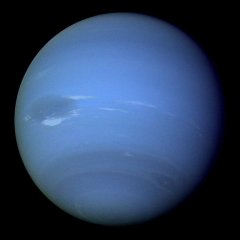Voyager 2 flew by Neptune thirty years ago this month and thus provided scientists with the first clear images of the blue gas giant. It is still the only spacecraft to have visited Neptune and Uranus.
On August 20, 1977, Voyager 2 launched, sixteen days before its sister ship, Voyager 1. Its mission from NASA was to tour the outer planets of the solar system, while Voyager 1 toured Jupiter, Saturn, and Titan, which is Saturn’s biggest moon. As Voyager 1 traveled to interstellar space, Voyager 2 continued on to Uranus and Neptune.
Voyager 2 reached Jupiter in July 1979, Saturn in August 1981, and Uranus in January 1986. It found previously unknown moons at all three planets. It also found faint rings around Jupiter and Uranus.
Neptune was Voyager 2’s last stop before heading into interstellar space. The scientists at NASA had decided to take advantage of a rare planetary alignment when planning Voyager 2’s trajectory. All four of the outermost planets were on the same side of the sun – an arrangement that occurs only once every 176 years. Voyager 2 could thus travel to the planets by using a gravity assist from the world it had just left.
Voyager 2’s flyby of Neptune lasted about a week, and the probe made its closest approach on August 25, 1989. The scientists could see a large storm in Neptune’s atmosphere that they dubbed the “Great Dark Spot.” It was gone when by the time the Hubble Space Telescope checked in 1993. Voyager 2 also found that Neptune had four faint rings and some of the solar system’s coldest and fastest winds.
When Voyager 2 examined Neptune’s biggest moon, Triton, they found it had a backward orbit. While some of Neptune’s moons had formed from leftover material when Neptune became a planet, Triton had been captured by Neptune’s gravity and pulled into a retrograde orbit. Triton was also the coldest object that Voyager 2 ever visited, with a surface temperature of -391° F (-235° C). It also had a geologically active surface with erupting methane geysers.
Voyager 2 also found six moons that were new to science.
Voyagers 1 and 2 have flown longer than any other spacecraft in history; they were both launched 42 years ago, and are still sending data back to NASA. Ironically, they were expected to last for only five years. The Voyager missions inspired other missions like the Juno and Galileo missions that visited Jupiter and its moons and the Cassini mission that visited Saturn and its moons.



